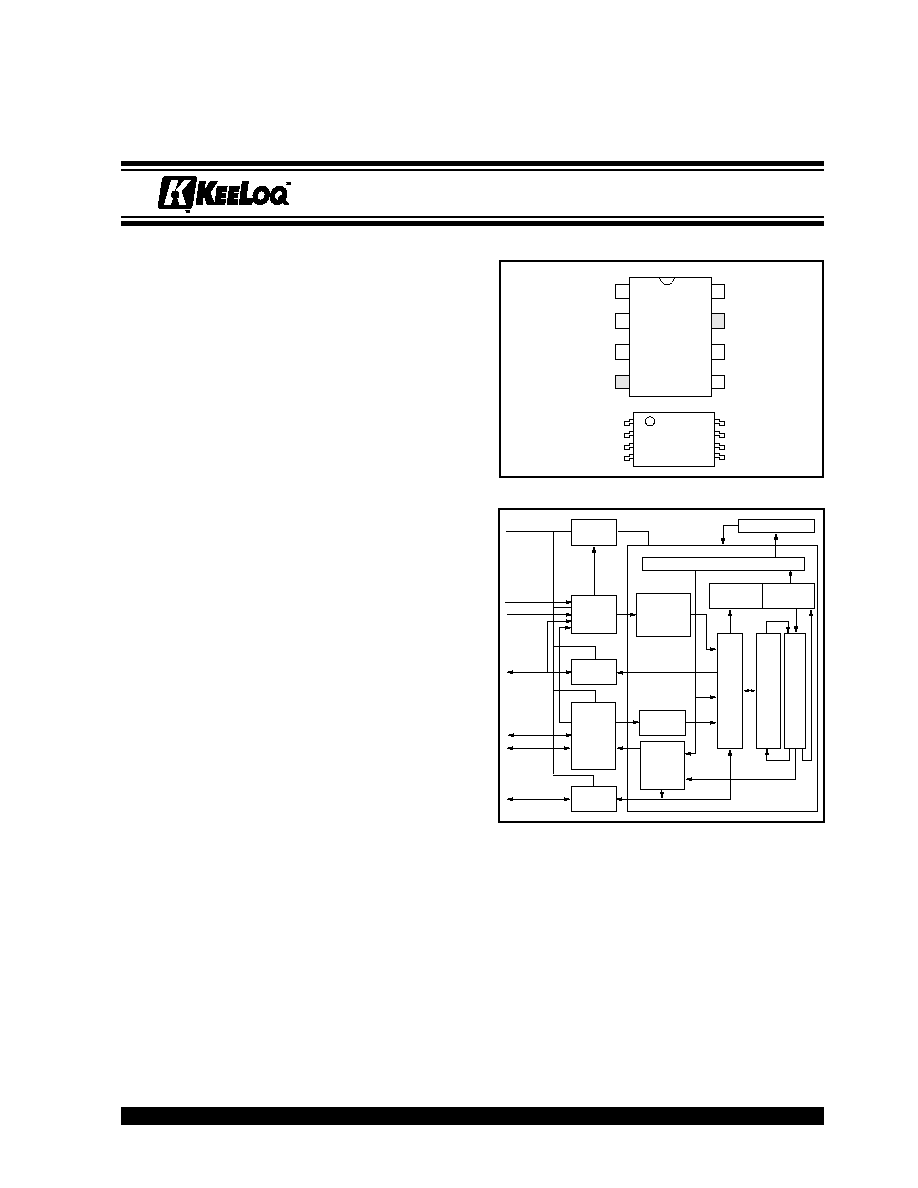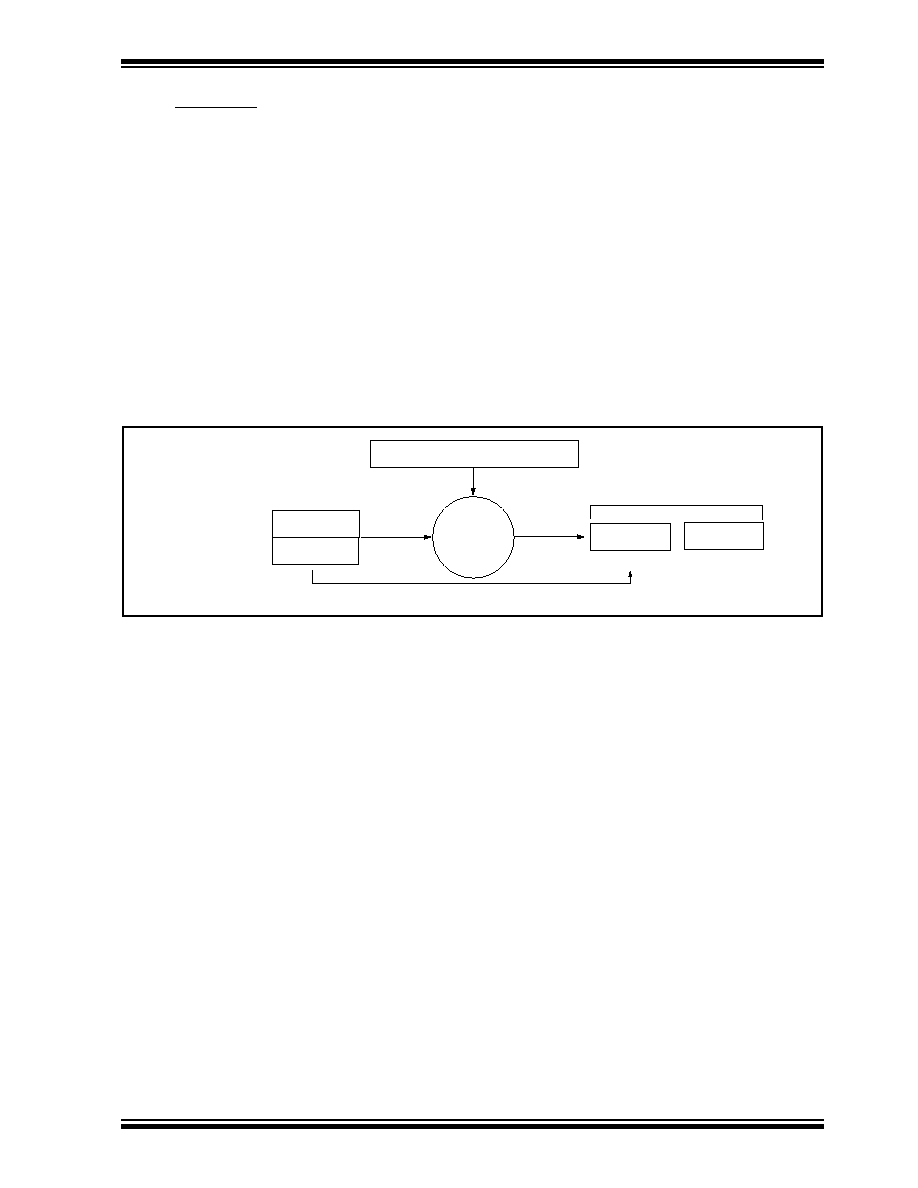
�
1997 Microchip Technology Inc.
Preliminary
DS40158C-page 1
M
HCS410
FEATURES
Security
� Two programmable 64-bit encoder keys
� 16/32-bit bi-directional challenge and response
using one of two keys
� 69-bit transmission length
� 32-bit unidirectional code hopping, 37-bit
nonencrypted portion
� Encoder keys are read protected
� Programmable 28/32-bit serial number
� 60/64-bit, read-protected seed for secure learning
� Three IFF encryption algorithms
� Delayed increment mechanism
� Asynchronous transponder communication
� Queuing information transmitted
Operating
� 2.0V to 6.6V operation, 13V encoder only
operation
� Three switch inputs [S2, S1, S0]--seven functions
� Batteryless bi-directional transponder
� Selectable baud rate and code word blanking
� Automatic code word completion
� Battery low signal transmitted
� Nonvolatile synchronization
� PWM or Manchester RF encoding
� Combined transmitter, transponder operation
� Anti-collision of multiple transponders
� Passive proximity activation
� Device protected against reverse battery
� Intelligent damping for high Q LC-circuits
Other
� 37-bit nonencrypted part contains 28/32-bit serial
number, 4/0-bit function code, 1-bit battery low,
2-bit CRC, 2-bit queue
� Simple programming interface
� On-chip tunable RC oscillator (
�
10%)
� On-chip EEPROM
� 64-bit user EEPROM in transponder mode
� Battery-low LED indication
� SQTP serialization quick-time programming
� 8-pin PDIP/SOIC/TSSOP and die
Typical Applications
� Automotive remote entry systems
� Automotive alarm systems
� Automotive immobilizers
� Gate and garage openers
� Electronic door locks (Home/Office/Hotel)
� Burglar alarm systems
� Proximity access control
PACKAGE TYPES
BLOCK DIAGRAM
HCS410
S0
S1
S2/LED
LC1
V
DD
LC0
PWM
GND
1
8
2
3
4
7
6
5
PDIP, SOIC
HCS410
S2/LED
LC1
GND
PWM
1
2
3
4
8
7
6
5
S1
S0
V
DD
LC0
TSSOP
Oscillator
Configuration Register
Power
Control
Wakeup
Logic
Address
DecodingEEPROM
Debounce
Control
and
Queuer
LED
Control
PWM
Driver
PPM
Detector
PWM
PPM
Manch.
Encoder
T
r
ansponder Circuitr
y
Control Logic and Counters
Encr
yption/Increment
Logic
Register
V
DD
S0
S1
S2
LCI0
LCI1
PWM
Code Hopping Encoder and Transponder*
K
EE
L
OQ
is a registered trademark of Microchip Technology Inc.
*Code hopping encoder patents issued in Europe, U.S.A., R.S.A.--U.S.A.: 5,517,187; Europe: 0459781

HCS410
DS40158C-page 2
Preliminary
�
1997 Microchip Technology Inc.
Table of Contents
1.0 System Overview .................................................................................................................................................... 3
1.1 Key Terms ........................................................................................................................................................ 3
1.2
K
EELOQ
Code Hopping Encoders ..................................................................................................................... 4
1.3 K
EE
L
OQ
IFF ...................................................................................................................................................... 5
2.0 Device Operation .................................................................................................................................................... 6
2.1 Pinout Description ............................................................................................................................................ 7
2.2 Code Hopping Mode (CH Mode) ..................................................................................................................... 8
2.3 Code Hopping Mode Special Features .......................................................................................................... 11
2.4 IFF Mode ........................................................................................................................................................ 14
2.5 IFF Opcodes .................................................................................................................................................. 17
2.6 IFF Special Features ...................................................................................................................................... 18
2.7 LED Indicator ................................................................................................................................................. 18
3.0 EEPROM Organization and Configuration ............................................................................................................ 19
3.1 Encoder Key 1 and 2 ..................................................................................................................................... 19
3.2 Discrimination Value and Overflow ................................................................................................................ 19
3.3 16-bit Synchronization Counter ...................................................................................................................... 19
3.4 60/64-bit Seed Word/Transport Code ............................................................................................................ 20
3.5 Encoder Serial Number .................................................................................................................................. 20
3.6 User Data ....................................................................................................................................................... 20
3.7 Configuration Data ......................................................................................................................................... 21
4.0 Integrating the HCS410 into a System .................................................................................................................. 23
4.1 Key Generation .............................................................................................................................................. 23
4.2 Learning an HCS410 to a Receiver ............................................................................................................... 24
4.3 CH Mode Decoder Operation ........................................................................................................................ 25
4.4 IFF Decoder Operation .................................................................................................................................. 27
5.0 Electrical Characteristics ....................................................................................................................................... 28
HCS410 Product Identification System ........................................................................................................................ 35

HCS410
�
1997 Microchip Technology Inc.
Preliminary
DS40158C-page 3
DESCRIPTION
The HCS410 is a code hopping transponder device
designed for secure entry systems. The HCS410 uti-
lizes the patented K
EELOQ
code hopping system and
bi-directional challenge-and-response for logical and
physical access control. High security learning mecha-
nisms make this a turnkey solution when used with the
K
EELOQ
decoders. The encoder keys and synchroniza-
tion information are stored in protected on-chip
EEPROM.
A low cost batteryless transponder can be imple-
mented with the addition of an inductor and two capac-
itors. A packaged module including the inductor and
capacitor will also be offered.
A single HCS410 can be used as an encoder for
Remote Keyless Entry (RKE) and a transponder for
immobilization in the same circuit and thereby dramat-
ically reducing the cost of hybrid transmitter/transpon-
der circuits.
1.0
SYSTEM OVERVIEW
1.1
Key Terms
� Anticollision � Allows two transponders to be in
the files simultaneously and be verified individu-
ally.
� CH Mode � Code Hopping Mode. The HCS410
transmits a 69-bit transmission each time it is acti-
vated, with at least 32-bits changing each time the
encoder is activated.
� Encoder Key � A unique 64-bit key generated and
programmed into the encoder during the manu-
facturing process. The encoder key controls the
encryption algorithm and is stored in EEPROM on
the encoder device.
� IFF � Identify friend or foe is a means of validating
a token. A decoder sends a random challenge to
the token and checks that the response of the
token is a valid response.
� K
EE
L
OQ
Encryption Algorithm � The high security
level of the HCS410 is based on the patented
K
EE
L
OQ
technology. A block cipher encryption
algorithm based on a block length of 32 bits and a
key length of 64 bits is used. The algorithm
obscures the information in such a way that even
if the unencrypted/challenge information differs by
only one bit from the information in the previous
transmission/challenge, the next coded transmis-
sion/response will be totally different. Statistically,
if only one bit in the 32-bit string of information
changes, approximately 50 percent of the coded
transmission will change.
� Learn � The HCS product family facilitates several
learning strategies to be implemented on the
decoder. The following are examples of what can
be done.
Normal Learn
�The receiver uses the same infor-
mation that is transmitted during normal operation to
derive the transmitter's encoder key, decrypt the dis-
crimination value and the synchronization counter.
Secure Learn*
� The transmitter is activated through
a special button combination to transmit a stored
60-bit value (random seed) that can be used for key
generation or be part of the key. Transmission of the
random seed can be disabled after learning is com-
pleted.
� Manufacturer's Code � A 64-bit word, unique to
each manufacturer, used to produce a unique
encoder key in each transmitter (encoder).
� Passive Proximity Activation � When the HCS410
is brought into in a magnetic field without a
command given by the base station, the HCS410
can be programmed to give an RF transmission.
� Transport Code � A 32-bit transport code needs
to be given before the HCS410 can be inductively
programmed. This prevents accidental
programming of the HCS410.
*Secure Learn patent pending.

HCS410
DS40158C-page 4
Preliminary
�
1997 Microchip Technology Inc.
1.2
K
EE
L
OQ
Code Hopping Encoders
When the HCS410 is used as a code hopping encoder
device, it is ideally suited to keyless entry systems,
primarily for vehicles and home garage door openers.
It is meant to be a cost-effective, yet secure solution to
such systems. The encoder portion of a keyless entry
system is meant to be carried by the user and operated
to gain access to a vehicle or restricted area.
Most keyless entry systems transmit the same code
from a transmitter every time a button is pushed. The
relative number of code combinations for a low end
system is also a relatively small number. These
shortcomings provide the means for a sophisticated
thief to create a device that `grabs' a transmission and
retransmits it later or a device that scans all possible
combinations until the correct one is found.
The HCS410 employs the K
EE
L
OQ
code hopping tech-
nology and an encryption algorithm to achieve a high
level of security. Code hopping is a method by which
the code transmitted from the transmitter to the
receiver is different every time a button is pushed. This
method, coupled with a transmission length of 69 bits,
virtually eliminates the use of code `grabbing' or code
`scanning'.
The HCS410 has a small EEPROM array which must
be loaded with several parameters before use. The
most important of these values are:
� A 28/32-bit serial number which is meant to be
unique for every encoder
� 64-bit seed value
� A 64-bit encoder key that is generated at the time
of production
� A 16-bit synchronization counter value.
� Configuration options
The 16-bit synchronization counter value is the basis
for the transmitted code changing for each transmis-
sion, and is updated each time a button is pressed.
Because of the complexity of the code hopping encryp-
tion algorithm, a change in one bit of the synchroniza-
tion counter value will result in a large change in the
actual transmitted code.
Once the encoder detects that a button has been
pressed, the encoder reads the button and updates the
synchronization counter. The synchronization counter
value, the function bits, and the discrimination value are
then combined with the encoder key in the encryption
algorithm, and the output is 32 bits of encrypted infor-
mation (Figure 1-1). The code hopping portion pro-
vides up to four billion changing code combinations.
This data will change with every button press, hence, it
is referred to as the code hopping portion of the code
word.
The 32-bit code hopping portion is combined with the
button information and the serial number to form the
code word transmitted to the receiver. The code word
format is explained in detail in Section 2.2.
FIGURE 1-1:
BASIC OPERATION OF A CODE HOPPING TRANSMITTER (ENCODER)
K
EE
L
OQ
Algorithm
Button Press
Information
Encryption
EEPROM Array
32 Bits of
Encrypted Data
Serial Number
Transmitted Information
Encoder Key
Sync Counter
Serial Number

HCS410
�
1997 Microchip Technology Inc.
Preliminary
DS40158C-page 5
1.3
K
EE
L
OQ
IFF
The HCS410 can be used as an IFF transponder for
verification of a token. In IFF mode the HCS410 is ide-
ally suited for authentication of a key before disarming
a vehicle immobilizer. Once the key has been inserted
in the car's ignition the decoder would inductively poll
the key validating it before disarming the immobilizer.
IFF validation of the token involves a random challenge
being sent by a decoder to a token. The token then gen-
erates a response to the challenge and sends this
response to the decoder (Figure 1-2). The decoder cal-
culates an expected response using the same chal-
lenge. The expected response is compared to the
response received from the token. If the responses
match, the token is identified as a valid token and the
decoder can take appropriate action.
The HCS410 can do either 16 or 32-bit IFF. The
HCS410 has two encryption algorithms that can be
used to generate a response to a challenge. In addition
there are up to two encoder keys that can be used by
the HCS410. Typically each HCS410 will be pro-
grammed with a unique encoder key(s).
In IFF mode, the HCS410 will wait for a command from
the base station and respond to the command. The
command can either request a read/write from user
EEPROM or an IFF challenge response. A given 16 or
32-bit challenge will produce a unique 16/32-bit
response, based on the IFF key and IFF algorithm
used.
FIGURE 1-2:
IBASIC OPERATION OF AN IFF TOKEN
IFF Key
Serial Number
K
EE
L
OQ
IFF
Algorithm
Serial Number
EEPROM Array
Challenge Received from Decoder
Response
Read by Decoder




